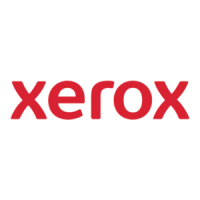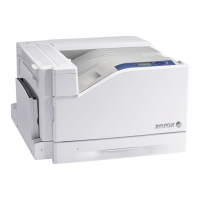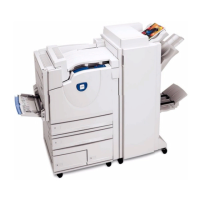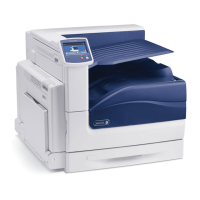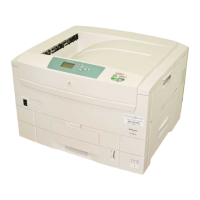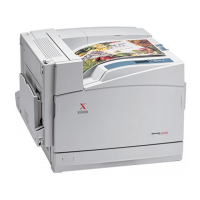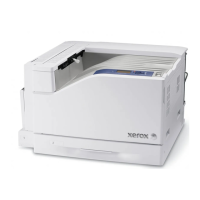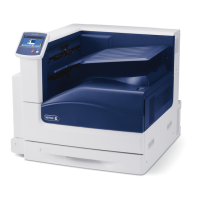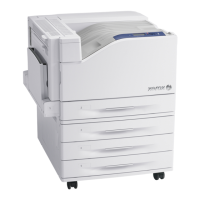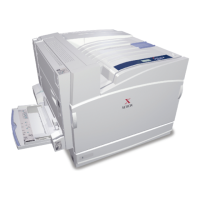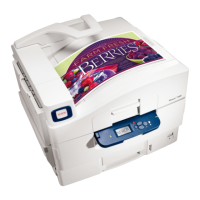






Do you have a question about the Xerox Phaser 7400 and is the answer not in the manual?
| Color | Yes |
|---|---|
| Print technology | Laser |
| Maximum resolution | 600 x 1200 DPI |
| Time to first page (black, normal) | 12 s |
| Print speed (black, normal quality, A4/US Letter) | 40 ppm |
| Print speed (color, normal quality, A4/US Letter) | 36 ppm |
| Storage media | HDD |
| Internal memory | 512 MB |
| Processor model | PowerPC |
| Maximum internal memory | 1 MB |
| Internal storage capacity | 20 GB |
| Total input capacity | 800 sheets |
| Maximum input capacity | 3000 sheets |
| Paper tray 2 input capacity | 350 sheets |
| Auto document feeder (ADF) input capacity | 1650 sheets |
| Maximum print size | 297 x 420 mm |
| Paper tray media types | Envelopes, Labels, Transparencies |
| Non-ISO print media sizes | Executive (184 x 267mm), Folio (media size), Letter (media size), Statement (140 x 216mm), Legal (media size) |
| Maximum ISO A-series paper size | A3 |
| Power requirements | 100-240V, 50/60Hz |
| Networking features | Fast Ethernet |
| Supported media weight(s) | 270 g/m² |
| Maximum operating temperature range (T-T) | 10 - 32 °C |
| Certification | FCC p.15 A, CE |
| Storage temperature (T-T) | -20 - 60 °C |
| Operating temperature (T-T) | -4 - 140 °F |
| Storage relative humidity (H-H) | 10 - 95 % |
| Operating relative humidity (H-H) | 20 - 80 % |
| Maximum duty cycle | 150000 pages per month |
| Dimensions (WxDxH) | 1438 x 623 x 975 mm |
|---|
Focuses on the print engine, covering specifications, theory, diagnosis, and repair.
Covers option repair, theory, FRU replacement, parts lists, and wiring diagrams.
Describes the service manual and provides a general overview of the printer.
Lists available printer configurations and their differences.
Explains metered printing, its operation, and related cartridges.
Identifies the printer's external components with front and rear views.
Describes the control panel's components, buttons, and shortcuts.
Details components installed on the Image Processor Board.
Lists optional features like hard drives, memory upgrades, and feeders.
Identifies printer configuration and stores network parameters.
Increases input capacity; attaches below Tray 2.
Adds three 550-sheet trays to the printer.
Adds two-sided printing functionality.
Increases output capacity with punching, stapling, and stacking.
Lists printer parts with limited life requiring periodic replacement.
Lists the four toner cartridges used in the printer.
Details memory, consumable life, electrical, and physical specs.
Provides voltage, frequency range, and power consumption details.
Lists physical size and required clearance for components.
Illustrates required space around the printer for operation.
Details printing process, resolution, and operating modes.
Specifies time from command receipt to page delivery.
Defines print area, margins, skew, registration, and linearity.
Lists operating temperature, humidity, and altitude limits.
Lists supported paper sizes, weights, and tray capacities.
Lists supported paper types, weights, and tray capacities.
Explains the printer's electrophotographic recording principles.
Describes the function of each imaging unit component.
Explains how LED Heads create a latent image.
Details how the Fuser bonds toner to paper using heat and pressure.
Lists Fuser components and their functions.
Explains how the Transfer Unit transports media and attracts toner.
Illustrates and describes the steps in producing a full-color print.
Describes the charge roller's function in applying negative charge to the drum.
Explains how LED Heads form a latent image on the drum.
Details how the Developer Roller applies toner to the latent image.
Explains how toner is transferred from the drum to the paper.
Describes how the Fuser bonds toner to paper using heat and pressure.
Explains how toner is removed from the Transfer Unit belt.
Describes how toner is scraped off the drum.
Details how paper exits to the Top or Side Output Trays.
Explains how excess toner is moved to the Waste Toner Reservoir.
Covers print-quality modes and color registration.
Lists four print-quality modes: Automatic, Standard, Enhanced, Photo.
Explains how color images are aligned using sensors.
Explains how color images are aligned using sensors.
Monitors toner density using test patches and ADC Sensor.
Describes default and optional tray identification.
Monitors environmental conditions for optimal transfer voltage.
Adjusts Fuser temperature based on media weight and environmental factors.
Determines new/in-use status of maintenance units via a fuse.
Describes various sensor types and their functions in the printer.
Details the four types of sensors used: Photo, Microswitches, Thermistors, Hall-Effect.
Explains photo-reflective and photo-receptive sensors.
Lists sensor types and their functions.
Used for paper size and door interlocks.
Used for Fuser temperature sensing.
Detects magnetic properties for waste toner and transfer belt monitoring.
Table listing sensor names, types, and functions.
Illustrates the location of each sensor within the printer.
Lists the function and sensor state for various sensors.
Lists sensor functions and states.
Explains how paper level is detected in trays.
Describes how the absence of paper is detected.
Explains OHP Sensor function for transparent media.
Adjusts fuser temp and speed based on media weight.
Explains how paper size is sensed using Paper Size Switches.
Describes how the printer checks for and detects paper jams.
Explains how interlock switches stop printer activity.
Describes how the Low Toner Sensor detects toner levels.
Explains how toner full state is determined by Agitation Bar timing.
Describes how toner low condition is detected by Agitation Bar timing.
Explains how toner is supplied to the Imaging Units.
Details input paper paths.
Details the paper path for media fed from Tray 1.
Details the paper path for media fed from Tray 2.
Describes paper path from optional trays 3 through 6.
Explains media movement through the Duplex Unit for two-sided printing.
Details paper paths exiting the Fuser to various output locations.
Describes Fuser and Exit rollers driven by the Fuser Motor.
Describes the facedown, 500-sheet tray on the printer's Top Cover.
Describes the faceup, 250-sheet tray on the printer's left side.
Summarizes output path through the Finisher.
Shows the location of all printer motors.
Explains how Imaging Unit Motors drive drums and agitation bars.
Describes the clockwise rotation of the Transfer Unit motor.
Explains the Fuser Motor drives the Fuser Heat and Pressure Rollers.
Explains the function of CM and YK Toner Dispense Motors.
Describes the two motors used to capture and transport paper in the Duplex Unit.
Contains assemblies related to the printer's frame and structure.
Allows Imaging Units to be raised for jam clearance.
Moves collected toner to the Waste Toner Reservoir.
Shows components associated with the Registration Assembly.
Handles media exiting the Fuser using rollers, solenoids, and gates.
Describes the motor and gear system for shifting media.
Details standard input trays including Tray 1 (MPT) and universal trays.
Feeds standard and custom size media into the printer.
Trays 2 through 6 with adjustable guides for paper size sensing.
Describes the feeder's sensors and board for communicating information.
Provides faceup output capacity with stack level monitoring.
Overviews major electrical components like boards, sensors, and fans.
The primary interface with display, keypad, and status LED.
Receives, buffers, and sends data to the print engine.
Synchronizes print process by controlling heads, motors, fans, sensors.
Includes sensors to monitor color registration.
Distributes power from LVPS to the four LED Heads.
Communicates with Engine Control Board, supplies voltage to fans.
Receives +24 V from LVPS and distributes power/control signals to motors.
Communicates sensor info to Motor Driver Board and provides connections.
Supplies high-voltage to Transfer Unit and Imaging Units.
Supplies AC power and generates low-voltage DC power for logic circuits.
Communicates with Motor Driver Board and connects to various sensors.
Communicates with Engine Control Board and connects to sensors.
Circulates air throughout the printer; notes fan orientation.
Used to actuate gates and rollers in the Print Engine.
Describes error messages, codes, and their entry into troubleshooting.
Lists three ways to access fault history records.
Outlines the service technician's path for troubleshooting.
Correlates diagnostic output with troubleshooting procedures.
Lists common abbreviations used in messages and procedures.
Illustrates door designators for jam location error codes.
Lists errors, codes, and page references for corrective procedures.
Continues the list of errors, codes, and corrective procedures.
Continues the list of errors, codes, and corrective procedures.
Lists fatal errors and their corresponding page references.
Continues the list of fatal errors and their page references.
Continues the list of fatal errors and their page references.
Continues the list of fatal errors and their page references.
Continues the list of fatal errors and their page references.
Provides guidance on how to use troubleshooting procedures effectively.
Explains how to perform electrical and mechanical measurements.
Basic steps to troubleshoot jam errors, ruling out mechanical factors.
Procedure for clearing jams at Door A.
Troubleshooting procedure for jams at Door A.
Troubleshooting procedure for jams at Door A.
Troubleshooting for misfeeds from Tray 1 (MPT).
Troubleshooting for misfeeds from Tray 2.
Continues troubleshooting for misfeeds from Tray 2.
Troubleshooting for jams in optional trays C3-C6.
Continues troubleshooting for jams in optional trays.
Troubleshooting for jams at Door D.
Troubleshooting for jams within the Duplex Unit.
Troubleshooting for jams at Door E in the Exit Assembly.
Continues troubleshooting for jams at Door E.
Troubleshooting for jams under the Imaging Units on the Transfer Unit belt.
Continues troubleshooting for jams under Imaging Units.
Troubleshooting for jams within the Fuser.
Continues troubleshooting for jams in the Fuser.
Troubleshooting for jams at the Duplex entrance or Exit Assembly.
Continues troubleshooting for jams at the Duplex entrance.
Troubleshooting for jams at the Finisher entrance.
Troubleshooting for jams in the Finisher Inverter.
Troubleshooting for multi-sheet jams in the Finisher.
Troubleshooting for jams in the Finisher upper output path.
Troubleshooting for jams in the Finisher staple path.
Troubleshooting for jams in the Finisher eject path.
Troubleshooting for jams within the Inverter path.
Troubleshooting for jams at the printer/finisher interface.
Troubleshooting for jams within the Inverter path.
Troubleshooting for jams in the Finisher eject path.
Troubleshooting for jams within the Inverter path.
Troubleshooting for jams at the printer/finisher interface.
Troubleshooting for obstructions or failures in the Finisher Upper Output Tray.
Continues troubleshooting for Finisher Upper Output Tray jams.
Troubleshooting procedures for various door and cover interlock errors.
Troubleshooting for an open Top Cover interlock switch.
Troubleshooting for an open Door A interlock switch.
Troubleshooting for an open Door B detected by the Tray 2 Feeder sensor.
Troubleshooting for an open Door C sensor on option trays.
Troubleshooting for an open Door D sensor on the Duplex Unit.
Troubleshooting for an open Door E detect sensor in the Exit Assembly.
Troubleshooting for an open Door F interlock switch.
Troubleshooting for an open Upper Cover (Door H) sensor.
Troubleshooting for an open Front Cover (Door J) sensor.
Procedures for replacing consumables and performing routine maintenance.
Procedure for replacing toner cartridges due to various errors.
Procedure when Imaging Unit life counter indicates end of life.
Procedure when Transfer Unit end of life counter requires replacement.
Procedure when Waste Toner Reservoir end of life counter requires replacement.
Procedure when Fuser life counter indicates end of life.
Procedure when printer does not detect toner cartridge or supply.
Procedure when Imaging Unit CRUM fails to detect the unit.
Procedure when printer does not detect the Transfer Unit.
Procedure when Waste Toner Reservoir Detect Switch indicates missing reservoir.
Procedure when Fuser Release Sensor indicates Fuser is missing.
Occurs when a metered toner cartridge is in a non-metered printer.
Procedure for metered operation with incorrect cartridge or error.
Troubleshooting procedures for tray and media related errors.
Procedure when Tray 1 Level Sensor indicates Registration Motor failed to raise media.
Continues procedure for Tray 1 Level Sensor issues.
Procedure when Lift Motor failed to raise media to pre-feed position.
Procedure when Tray 1 No Paper Sensor indicates tray is empty.
Procedure when No Paper Sensor indicates tray is empty for trays 2-6.
Addresses errors when manual feed media size/type does not match job specification.
Troubleshooting when Full Stack Sensor indicates the output tray is full.
Troubleshooting when Full Stack Sensor indicates the Side Output Tray is full.
Troubleshooting when output tray is full.
Troubleshooting when output tray is full.
Troubleshooting when Side Output Tray Detect Sensor indicates tray is closed.
Troubleshooting procedures for media mismatch errors.
Procedure for Tray 1 MPT paper size mismatch.
Procedure for Tray 2 paper size mismatch.
Procedure for paper size mismatch in trays 3-6.
Procedure for media type mismatch detected by Media Thickness Sensor.
Procedure for Tray 1 MPT paper not available error.
Procedure for Tray 2 paper not available error.
Procedure for paper not available error in trays 3-6.
Troubleshooting procedures for configuration-related errors.
Troubleshooting when the printer's Configuration Card is missing or defective.
Troubleshooting when another device uses the printer's IP address.
Procedures for resolving fatal errors detected by the printer.
Procedure when Fuser temperature regulation fails.
Illustrates electrical connections for the Fuser Unit.
Procedure when the Temperature Sensor fails.
Procedure for humidity sensor failure or condensation detection.
Troubleshooting for LED Head overheating.
Troubleshooting when Imaging Unit motors overheat.
Procedure when an Engine Control Board error is detected.
Troubleshooting for LVPS overvoltage or undervoltage conditions.
Procedure when Tray 1 (MPT) does not reach home position.
Troubleshooting when the Image Processor Board Fan fails.
Troubleshooting when the LVPS Fan fails.
Troubleshooting when the Top Cover Fan fails.
Troubleshooting when an Imaging Unit Fan fails.
Troubleshooting when the Transfer Unit Fan fails.
Troubleshooting when the Card Cage Fan has stopped rotating.
Troubleshooting communication errors with the Duplex Unit.
Troubleshooting communication failures in the option tray interface.
Troubleshooting communication errors in the Finisher Inverter.
Troubleshooting for Yellow, Magenta, Cyan, or Black LED Head failures.
Troubleshooting when the Drum Phase Sensor indicates the drum is out of position.
Continues troubleshooting for Imaging Unit drum or motor failures.
Troubleshooting when the Flash Memory device on the Engine Control Board fails.
Troubleshooting when the Fuser Fan rotation signal indicates failure.
Procedure when an incorrect Fuser voltage is detected.
Troubleshooting when the installed Duplex Unit has incorrect firmware.
Troubleshooting when Tray 2 firmware is unsupported.
Troubleshooting for incompatible LTA or HCF assemblies.
Troubleshooting when an incompatible Inverter assembly is detected.
Troubleshooting when an incompatible Finisher is detected.
Troubleshooting when an error is detected in the Hard Drive.
Procedure when the in-use fuse for the Fuser remains intact.
Procedure when the in-use fuse for the Transfer Unit remains intact.
Procedure when the in-use fuse for the Imaging Unit remains intact.
Troubleshooting when a communications error is detected.
Troubleshooting when an error is detected with the Fold Position Sensor.
Troubleshooting when an error is detected in the Finisher Paddle Motor.
Troubleshooting when the Stapler Swing Home Position Sensor detects a motor error.
Troubleshooting when the Delivery Belt Home Position Sensor detects a Stack Handling error.
Troubleshooting when an error is detected in the Staple Motor.
Troubleshooting when an error is detected in the Front or Rear Alignment Motor.
Troubleshooting when the Paper Surface, Upper Limit, or Lift Motor Clock Sensor detects a Lift Motor error.
Continues troubleshooting for Lift Motor failures.
Troubleshooting when the Delivery Belt Home Position Sensor detects a Delivery Motor error.
Troubleshooting when an error is detected in the Punch Side Registration Sensor.
Troubleshooting when an error is detected in the Horizontal Registration Home Position Sensor.
Troubleshooting when an error is detected in the Punch Unit's backup RAM.
Troubleshooting when a communications error occurred with the Punch Unit.
Troubleshooting when an error was detected in the Punch Transfer Motor.
Troubleshooting when an error was detected in the Punch Motor.
Troubleshooting when an error was detected in the Finisher’s backup RAM.
Troubleshooting when an error was detected in the Punch Waste Sensor.
Procedures for codes associated with the Printer Error message.
Procedure when Punch Count indicates end of life.
Procedure when Stapler Self-Prime Sensor indicates no staples remain.
Troubleshooting serial communications errors with the Finisher.
Troubleshooting when an inverter hardware error is detected.
Lists and describes various Fuser thermistor error codes.
Troubleshooting when the Job Offset Home Position Sensor fails.
Troubleshooting communication errors with the Control Panel.
Troubleshooting errors related to LED Head data communication.
Troubleshooting Sub-CPU communications errors with installed options.
Troubleshooting software errors in Tray 3-6 Flash Memory.
Troubleshooting firmware errors with the Duplex Unit.
Troubleshooting software errors in the Motor Driver Board Flash Memory.
Troubleshooting software errors with the Inverter's Flash Memory.
Troubleshooting errors when the CRUM Reader Board does not respond or has communication issues.
Troubleshooting hardware errors in Tray 3-6 Flash Memory.
Troubleshooting hardware failures with Duplex Unit Flash Memory.
Troubleshooting hardware failures with Motor Driver Board Flash Memory.
Troubleshooting hardware failures with Inverter Flash Memory.
Troubleshooting when the Tray 2 Lift Motor is not rotating.
Troubleshooting when lift motors for trays 3-6 fail.
Continues troubleshooting for lift motor failures in trays 3-6.
Troubleshooting when the Transfer Belt Rotation Sensor indicates an error.
Troubleshooting when the Duplex Fan has failed.
Troubleshooting when +24V is not supplied to the Duplex Unit.
Troubleshooting when the Drum Phase Sensor indicates drum out of position.
Continues troubleshooting for Imaging Unit drum/motor failures.
Troubleshooting when +24V is not available to indicated option tray.
Troubleshooting when the Fuser Motor has stopped rotating.
Troubleshooting when the Waste Toner Motor has stopped rotating.
Troubleshooting inaccurate Sub-CPU clock frequency on Motor Driver Board.
Troubleshooting inaccurate clock frequency for Duplex Unit Control Board CPU.
Troubleshooting inaccurate clock frequency for Inverter Control Board CPU.
Troubleshooting inaccurate clock frequency for indicated Feeder Board.
Troubleshooting when Waste Toner Auger Rotation Sensor indicates stopped rotation.
Continues troubleshooting for Waste Toner Auger errors.
Troubleshooting when Low Toner Sensor indicates supply failure.
Lists warning messages and their corresponding page references.
Procedure when Tray 1 No Paper Sensor indicates the tray is empty.
Procedure when No Paper Sensor indicates the named tray is empty for trays 2-6.
Warning when Side Output Tray Detect Sensor indicates the tray is closed.
Troubleshooting when Waste Toner Reservoir Full Sensor indicates the reservoir is full.
Warning message when non-Xerox toner is detected.
When Stapler Self-Prime Sensor indicates no staples remain.
Troubleshooting when Punch Box Sensor indicates the box is full or not installed.
Troubleshooting when Finisher Switch indicates detachment from Inverter.
Troubleshooting when Inverter Docking Switch indicates detachment from printer.
Isolates defective subsystems using soft and hard faults.
Provides tests for electro-mechanical components and NVRAM access.
Addresses issues with the control panel display and buttons.
Troubleshooting steps when the control panel has no display.
Troubleshooting steps when the control panel display is blank.
Steps for when the printer does not operate after power switch activation.
Lists firmware checks performed at each printer power-up.
Addresses issues with Image Processor Board NVRAM content loading.
Refers to procedure on page 3-65.
Troubleshooting steps for reseating the controller board.
Refers to AC power and fault isolation troubleshooting.
Explains how the assembly actuates the Paper Size Switch for error detection.
Continues explanation of Paper Size Switch testing and signals.
Discusses LVPS overcurrent, overvoltage, and interlock switch issues.
Circuit stops outputs if DC power supply detects a short circuit.
Circuit stops outputs if DC power supply exceeds specified voltage.
Explains how interlock switches shut off +24 VDC supply.
Procedures for troubleshooting AC power supply issues.
Procedures for troubleshooting DC power supply issues.
Addresses RAM failures or installation issues.
Continues troubleshooting steps for RAM memory issues.
Explains troubleshooting for media jams and paper path issues.
Checks media type, condition, and path for issues.
Troubleshooting steps for picking multiple sheets of paper.
Troubleshooting steps for incorrect paper picking.
Continues troubleshooting for media jams and paper path issues.
Addresses images not parallel with page edges, causing jams.
Troubleshooting for wrinkled, creased, or torn printed pages.
Troubleshooting steps for jams occurring in the Fuser area.
Troubleshooting for jams in the Fuser and Exit Assembly.
Addresses printing issues related to OS and applications.
Specific steps for diagnosing Macintosh printing issues.
Specific steps for diagnosing Windows printing issues.
Troubleshooting steps when no image prints.
Provides diagnostic tools to resolve networking issues.
Basic steps to take before troubleshooting network issues.
Runs TCP/IP connection tests and displays results.
Continues troubleshooting network issues.
Steps to verify printer's Ethernet port functionality on Windows.
Steps to verify printer's Ethernet port functionality on Mac OS X.
Tests the printer's USB Port directly using a USB cable.
Attributes defects to components, consumables, media, or software.
Lists common print-quality problems by component.
Lists common defects like streaks, banding, voids, and mis-registration.
Lists common defects like toner on back, light prints, and mis-registration.
Lists common defects like offsetting and dark streaks.
Lists common defects like streaks and uneven density.
Explains how to select and analyze test prints for troubleshooting.
Guides analysis of CMYK, Blue, and Green solid fill pages for defects.
Guides analysis of CMYK, color, and PS pattern pages for defects.
Guides analysis of PS pattern for color registration and density.
Guides analysis of CMYK graduated fills for defects.
Troubleshooting for overall light image density in all colors.
Continues troubleshooting for light prints in all colors.
Troubleshooting for light images in a single color (Y, M, C, or K).
Continues troubleshooting for light prints in a single color.
Troubleshooting steps when the entire test print is blank.
Troubleshooting for mottled print appearance, often due to humidity.
Continues troubleshooting for mottled print appearance.
Troubleshooting when colors are different from expected.
Troubleshooting for repeating defects, often caused by damaged rollers.
Troubleshooting for light areas or missing spots not repeating or single color.
Continues troubleshooting for random image defects.
Troubleshooting for toner spots scattered across the page.
Continues troubleshooting for random toner spots.
Troubleshooting for light toner covering across the page.
Continues troubleshooting for background toner contamination.
Troubleshooting faint, ghostly images on the page.
Troubleshooting when Fuser temperature is too low for media, causing improper fusing.
Troubleshooting blurred images where primary colors don't align correctly.
Troubleshooting dark lines parallel to paper travel, due to toner debris.
Troubleshooting light or missing areas forming bands along the page.
Troubleshooting dark lines parallel to the print's leading edge.
Troubleshooting dark lines parallel to paper travel, due to toner debris.
Procedures to adjust printer for optimal color output and settings.
Adjusts printer for optimal color output; settings may need adjustment.
Allows adjustment of printer's imaging area relative to paper edges.
Ensures predictable and repeatable color image quality.
Inputting color chip reference value to adjust ADC sensor.
Executes density calibration and reports pass/fail status.
Measures media thickness to adjust Fuser temp and print speed.
Verifies ATS operation using premeasured media.
Enters premeasured media thickness in mils or microns.
Covers vertical and horizontal color registration adjustments.
Discusses automatic and manual adjustment options for color registration.
Vertical adjustment is automatic; no manual process available.
Automatic and manual options for horizontal color registration.
Restores printer configuration settings to factory defaults.
Resets density and color balance settings to factory defaults.
Restores color settings from before the last balance adjustments.
Resets margin settings to the factory-default values.
Resets connection values to factory defaults.
Resets PostScript setup values to their default values.
Resets PCL setup values to their default values.
Resets control panel language, brightness, and accessibility settings.
Resets startup page, power saver, date/time, and other printer controls.
Restores Image Processor Board NVRAM parameters to factory defaults.
Provides utilities for NVRAM access and resetting.
Restores NVRAM values to factory defaults.
Displays current life count of consumables.
Sets life counts of consumables to Zero.
Procedures for checking, servicing, or repairing the printer.
Lists tools required for cleaning and maintenance.
Provides general cleaning steps based on printer operating environment.
Procedure to clean the four contacts at the front of the Imaging Unit.
Cleans accumulated dust from the Feed Rollers.
Contains removal/replacement procedures for selected parts (FRUs).
Provides preparation, cautions, and notations for disassembly procedures.
Lists maintenance items like Transfer Unit and Fuser, and consumables.
Procedure for removing the Imaging Unit, which includes toner cartridges.
Procedure for removing toner cartridges, facilitating other component removal.
Procedure for removing the Transfer Unit.
Procedure for removing the Fuser assembly.
Disassembly procedures for various printer covers.
Procedure to remove the rear cover.
Procedure to remove the lower rear cover.
Procedure to remove the right rear cover.
Procedure to remove the right side cover, may require lifting print engine.
Procedure to remove the left side cover.
Procedure to remove the front door.
Procedure to remove Door B.
Procedure to remove the left rear cover.
Procedure to remove the left front cover.
Procedure to remove the upper front cover.
Procedure to remove the top cover.
Procedures for removing printer trays and related components.
Procedure to remove Tray 1 (MPT) and its associated components.
Procedure to remove the level sensor from the feed roller assembly.
Procedure to remove the home position sensor from the registration assembly.
Procedure to remove the OHP sensor from Tray 1 (MPT).
Procedure to remove the feed-out sensor from Tray 1 (MPT).
Procedure to remove the no paper sensor from Tray 1 (MPT).
Procedure to remove the feed rollers from Tray 1 (MPT).
Procedure to remove the Tray 2 Feeder assembly.
Procedure to remove the Registration Motor from the Feeder.
Procedure to remove the Feed Motor from the Feeder.
Procedure to remove the Lift Motor from the frame.
Procedure to remove the Registration Clutch #2.
Procedure to remove the Door B Detect Sensor.
Procedure to remove the No Paper Sensor housing.
Procedure to remove the Registration Sensor #2.
Procedure to remove the Feed-Out Sensor #2.
Procedure to remove the Feeder Board.
Procedure to remove feed rollers from Tray 2.
Procedure to remove the Side Output Tray.
Procedures for disassembling chassis components.
Procedure to remove the Job Offset Assembly.
Procedure to remove the Job Offset Motor.
Procedure to remove the Job Offset Home Position Sensor.
Procedure to remove the Top Output Chute.
Procedure to remove the Door A Latch Assembly.
Procedure to remove the Media Thickness Sensor.
Procedure to remove the Temperature/Humidity Sensor.
Procedure to remove the Exit Assembly.
Procedure to remove the Exit Gate Solenoid.
Procedure to remove the Fuser Exit Sensor and Actuator.
Procedure to remove the Top Output Tray Stack Full Sensor.
Procedure to remove the Side Output Tray Detect Sensor.
Procedure to remove the Side Output Tray Stack Full Sensor.
Procedure to remove the Door E Detect Sensor.
Procedure to remove the Fuser Release Sensor.
Procedure to remove the Registration Sensor Assembly.
Procedure to remove the Registration Shutter Solenoid.
Procedure to remove the ADC Sensor.
Procedure to remove the Media Slack Sensor and Actuator.
Procedure to remove the Registration Assembly.
Procedure to remove the Registration Clutch #1.
Procedure to remove the Waste Toner Auger Assembly.
Procedure to remove the Waste Toner Reservoir Full Sensor.
Procedure to remove the Waste Toner Reservoir Auger Rotation Sensor.
Procedure to remove the Waste Toner Auger Rotation Sensor.
Procedure to remove the Transfer Unit Belt Rotation Sensor.
Procedure to remove the Lower Basket Assembly.
Procedure to remove the Basket Assembly.
Procedure to remove the LED Assembly.
Procedures for removing drive components.
Procedure to remove the Transfer Unit Motor.
Procedure to remove the Toner Motors.
Procedure to remove the Imaging Unit Motors.
Procedure to remove the Fuser Motor.
Procedure to remove the Waste Toner Motor.
Procedure to remove the Imaging Unit Lift Uplink.
Procedure to remove the Front Lift Uplink.
Procedures for disassembling electrical components.
Procedure to remove the Control Panel assembly.
Procedure to remove the Engine Control Board.
Procedure to remove the Image Processor Board.
Procedure to remove the Card Cage Fan Duct.
Procedure to remove the Card Cage Fan.
Procedure to remove the Card Cage.
Procedure to remove the HVPS Cover.
Procedure to remove the High Voltage Power Supply.
Procedure to remove the Housing Bias Assembly.
Procedure to remove the LVPS enclosure.
Procedure to remove the LVPS Fan.
Procedure to remove the LED Head.
Procedure to remove the LED Relay Board.
Procedure to remove the Top Cover Interlock Switch.
Procedure to remove the Waste Toner Reservoir Detect Switch.
Procedure to remove the Door A Interlock Switch.
Procedure to remove the Imaging Unit Fan.
Procedure to remove the Transfer Unit Fan.
Procedure to remove the Top Cover Fan.
Procedure to remove the IP Fan.
Procedure to remove the Paper Size Switch.
Procedure to remove the Motor Driver Board.
Procedure to remove the Imaging Unit Sensor Board.
Procedure to remove the Toner Supply Camshafts.
Procedure to remove the Imaging Unit Motor Mounting Plate.
Procedure to remove the CRUM Reader Board.
Procedure to remove the CRUM Antenna.
Procedure to remove the Registration Sensor Board.
Procedure to remove the Fuser Fan.
Procedure to remove the Front Sensor Board.
Procedure to remove the Rear Sensor Board.
Explains the coding format of the printer's serial number.
Provides guidance on how to use the parts list for ordering.
Exploded view and list of parts for the main print engine assembly.
Lists toner cartridges, maintenance items, and upgrade kits.
Lists kits developed for obtaining spare parts.
Provides replacement rollers for the Feeder Assemblies.
Provides replacement sensor actuators.
Provides replacement sensor actuators.
Lists various types of screws used in printer assembly.
Lists hardware components like springs, pins, and rings.
Lists various gears used in the printer's drive mechanisms.
Lists various wire and connector harnesses.
Shows primary connections within the printer and optional feeders.
Lists connections for the print engine, including coordinates and remarks.
Continues listing print engine connections and remarks.
Illustrates wiring for the print engine and its components.
Shows general wiring for the print engine, part 1 of 7.
Shows general wiring for the print engine, part 2 of 7.
Shows general wiring for the print engine, part 3 of 7.
Shows general wiring for the print engine, part 4 of 7.
Shows general wiring for the print engine, part 5 of 7.
Shows general wiring for the print engine, part 6 of 7.
Shows general wiring for the print engine, part 7 of 7.
Wiring diagram for the front sensor board, part 1 of 2.
Wiring diagram for the front sensor board, part 2 of 2.
Wiring diagram for the feeder board.
Wiring diagram for the motor driver board, part 1 of 6.
Wiring diagram for the motor driver board, part 2 of 6.
Wiring diagram for the motor driver board, part 3 of 6.
Wiring diagram for the motor driver board, part 4 of 6.
Wiring diagram for the motor driver board, part 5 of 6.
Wiring diagram for the motor driver board, part 6 of 6.
Wiring diagrams for the LED Heads and their connections.
Wiring diagrams for the xerographic components.
Wiring diagram for the High Voltage Power Supply.
Wiring diagram for the Low Voltage Power Supply.
Wiring diagram for the Fuser assembly.
Wiring diagram for the Imaging Unit Sensor Board.
Wiring diagram for the Image Processor Board.
Wiring diagram for the Control Panel.
Provides a visual representation of the printer's menu structure.
Defines status codes found in Service Usage Profile and Fault History.
Maps the menu structure for Service Diagnostics, part 1 of 2.
Maps the menu structure for Service Diagnostics, part 2 of 2.
Lists tests and their functional definitions.
Continues listing tests and their functional definitions.
Continues listing tests and their functional definitions.
Continues listing tests and their functional definitions.
Continues listing tests and their functional definitions.
Continues listing tests and their functional definitions.
Continues listing tests and their functional definitions.
Continues listing tests and their functional definitions.
Continues listing tests and their functional definitions.
Continues listing tests and their functional definitions.
Continues listing tests and their functional definitions.
Continues listing tests and their functional definitions.
Continues listing tests and their functional definitions.
A 6-pin port for placing the printer in operational or service modes.
Steps to obtain a back channel trace for troubleshooting printer behavior.
Instructions for preparing and packaging the printer for shipment.
